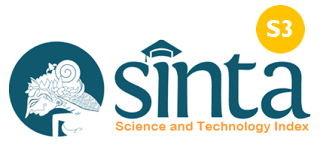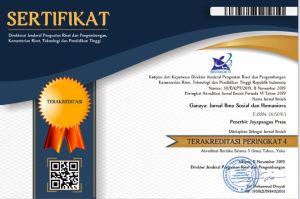Analisis Faktor Penyebab dan Dampak Kualitas Belajar Mahasiswa Berbasis Daring di Masa Pandemi Covid-19
DOI:
https://doi.org/10.37329/cetta.v4i3.1478Keywords:
E-Learning, Lecturer Competence, Motivation, Learning Quality, Learning EffectivenessAbstract
The e-learning system can create individuation, enrichment, acceleration, expansion, productivity and effectiveness in learning so that the quality of education can increase during the Covid-19 pandemic. This research was conducted to find the right formulation of the online lecture system in the future. In this study, the research population was all students of the communication science study program, totaling 259 people. For the needs of analysis and hypothesis testing, the entire population is used as the research sample. So the research is included in population research. The analytical technique used in this study uses a structural equation model (SEM) with the AMOS 21.0 program which consists of several stages. The results showed that of the nine paths and hypotheses built, seven hypotheses had a positive and significant effect, while two hypotheses had an insignificant effect.
References
Arizona, K., Abidin, Z., & Rumansyah, R. (2020). Pembelajaran Online Berbasis Proyek Salah Satu Solusi Kegiatan Belajar Mengajar Di Tengah Pandemi COVID-19. Jurnal Ilmiah Profesi Pendidikan, 5(1), 64–70. https:// doi.org/10.29303/jipp.v5i1.111
Damayanthi, Adriana (2020). Efektivitas Pembelajaran Daring di Masa Pandemi Covid-19 Pada Perguruan Tinggi Keagamaan Katolik. Edutech 19(3), 2020.
Divayana, D. G. H. (2017). Evaluasi pemanfaat e-learning menggunakan model CSE-UCLA. Cakrawala Pendidikan. Th. XXXVI(2), 280-289.
Ferdinand, Augusty (2006). Structural equation modeling dalam penelitian manajemen. Badan Penerbit Universitas Diponegoro, Semarang
Ferdinand, Augusty (2006). Metode penelitian manajemen : pedoman penelitian untuk penulisan skripsi, tesis dan disertasi ilmu manajemen. Badan Penerbit Universitas Diponegoro, Semarang
Fitriasari, P., Tanzimah, T., & Sari, N. (2018). Kemandirian belajar mahasiswa melalui blended learning pada mata kuliah metode numerik. Jurnal Elemen, Vol. 4(1), 1. https://doi.org/10.29408/jel.v4i1.439.
Ghozali, Imam (2008). Model Persamaan Struktural : Konsep & aplikasi dengan program AMOS 16.0. Badan Penerbit Universitas Diponegoro, Semarang
Ghozali, Imam (2009). Aplikasi analisis multivariate dengan program SPSS. Badan penerbit universitas Diponegoro, Semarang
Hair, Joseph F., Jr., et.al. (1998). Multivariate data analysis. fifth edition. USA : prentice-Hall International, Inc.
Hair, Joseph F., Jr., et.al (2006). Multivariate data analysis. sixth edition. New Jersey : Pearson educational, Inc.
Herliandry, L. D., Nurhasanah, N., Suban, M. E., & Kuswanto, H. (2020).Pembelajaran Pada Masa Pandemi COVID-19. JTP - Jurnal Teknologi Pendidikan, 22(1), 65– 70. https://doi.org/10.21009/ jtp.v22i1.15286
Irhandayaningsih, A. (2020). Pengukuran Literasi Digital Pada Peserta Pembelajaran Daring di Masa Pandemi COVID-19. Anuva, 4(2), 231–240.
Jusmawati, Satriawati, Bellona Mardhatillah Sabillah (2020). Pengaruh pembelajaran berbasis daring terhadap minat belajar mahasiswa pgsd unimerz pada mata kuliah pendidikan matematika.
Karim, Bisyri Abdul (2020). Pendidikan Perguruan Tinggi Era 4.0 Dalam Pandemi Covid-19 (Refleksi Sosiologis). Education and Learning Journal Vol. 1, No. 2, Juli 2020, pp. 102-112
Karwati, Euis (2014). Pengaruh pembelajaran elektronik (e-learning) terhadap mutu belajar mahasiswa.
Kusnayat, Agus; Moh. Hifzul Muiz; Nani Sumarni; Agus Salim Mansyur; Qiqi Yuliati Zaqiah (2020). Pengaruh Teknologi Pembelajaran Kuliah Online di Era Covid-19 dan Dampaknya Terhadap Mental Mahasiswa. Jurnal Edukasi dan Teknologi Pembelajaran Volume 1, No. 2 Edisi Juni 2020
Kusnendi, (2008). Model-model persamaan struktural : satu dan multigroup sampel dengan Lisrel. Penerbit Alfabeta, Bandung
Mustakim. (2020). Efektivitas Pembelajaran Daring Menggunakan Media Online Selama Pandemi COVID-19 Pada Mata Pelajaran Matematika the Effectiveness of E-Learning Using Online Media During the COVID19 Pandemic in Mathematics. Al Asma: Journal of Islamic Education, 2(1), 1–12.
Mustofa, M. I., Chodzirin, M., Sayekti, L., & Fauzan, R. (2019). Formulasi model perkuliahan daring sebagai upaya menekan disparitas kualitas perguruan tinggi. Walisongo Journal of Information Technology, Vol. 1(2), 151. https://doi.org/10.21580/wjit.2019.1.2.4067.
Ningsih, Desak Made Rai (2020). Pengaruh Metode Kuliah Online Terhadap Tingkat Pemahaman Materi Kuliah Hukum Investasi Pada Mahasiswa Universitas Teknologi Indonesia. Jurnal Pendidikan, Volume 21, Nomor 2, September 2020, 104-110
Oktavian, R., & Aldya, R. F. (2020). Efektivitas Pembelajaran Daring Terintegrasi di Era Pendidikan 4.0. Didaktis: Jurnal Pendidikan Dan Ilmu Pengetahuan, 20(2), 129–135. https://doi.org/10.30651/ didaktis.v20i2.4763
Prayudi, Y. (2009). Prosiding seminar nasional aplikasi teknologi informasi (SNATI). Kajian Awal: E-Learning REadiness Index (ELRI) sebagai model bagi evaluasi e-learning pada sebuah institusi, 2009 (Snati). Retrieved from http://journal.uii.ac.id/index.php/Snati/article/view/953/909.
Sudiksa IM , DGH Divayana, IWS Warpala (2020). Pengaruh e-learning dan lingkungan kampus terhadap minat belajar mahasiswa dengan motivasi belajar sebagai variabel mediasi. Jurnal Teknologi Pembelajaran Indonesia
Sukerti, N. M. B. (2016). Pengaruh model pembelajaran inkuiri terbimbing dan motivasi belajar terhadap hasil belajar IPA. Tesis (Tidak diterbitkan). Program Magister Teknologi Pembelajaran Program Pascasarjana Universitas Pendidikan Ganesha.
Widiyono, A. (2020). Efektifitas Perkuliahan Daring (Online) pada Mahasiswa PGSD di Saat Pandemi Covid 19. Jurnal Pendidikan, 8(2), 169–177. https://doi.org/10.36232/ pendidikan.v8i2.458
Yuniarti, R. D. (2010). Meningkatkan kualitas pembelajaran di Prodi Tata Niaga Jurusan pendidikan ekonomi FPEB-UPI. 8(16), 66–77.
Downloads
Published
How to Cite
Issue
Section
License
An author who publishes in the Cetta : Jurnal Ilmu Pendidikan agrees to the following terms:
- Author retains the copyright and grants the journal the right of first publication of the work simultaneously licensed under the Creative Commons Attribution-ShareAlike 4.0 License that allows others to share the work with an acknowledgement of the work's authorship and initial publication in this journal
- Author is able to enter into separate, additional contractual arrangements for the non-exclusive distribution of the journal's published version of the work (e.g., post it to an institutional repository or publish it in a book) with the acknowledgement of its initial publication in this journal.
- Author is permitted and encouraged to post his/her work online (e.g., in institutional repositories or on their website) prior to and during the submission process, as it can lead to productive exchanges, as well as earlier and greater citation of the published work (See The Effect of Open Access).
Read more about the Creative Commons Attribution-ShareAlike 4.0 Licence here: https://creativecommons.org/licenses/by-sa/4.0/.





